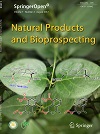|
|
Steroidal Saponins from the Genus Smilax and Their Biological Activities
Collect
Li-Wen Tian, Zhen Zhang, Hai-Lan Long, Ying-Jun Zhang
Natural Products and Bioprospecting. 2017, 7 (4): 283-298.
DOI: 10.1007/s13659-017-0139-5
The Smilax species, widely distributed in tropical region of the world and the warm areas of East Asia and North America, are extensively used as folk medicine to treat inflammatory disorders. Chemical investigation on Smilax species showed they are rich sources of steroidal saponins with diversified structure types, including spirostane, isospirostane, furostane, pregnane, and cholestane. This review mainly summarizes the steroidal saponins (1-104) reported from the genus Smilax between 1967 and 2016, and their biological activities. The relationship between structures of steroidal saponins and related biological activities were briefly discussed.
References |
Related Articles |
Metrics
|
|
|
Improvement of Fermented Fish Flour Quality Using Essential Oil Extracted From Fresh Leaves of Pimenta racemosa (Mill.) J. W. Moore
Collect
Euloge S. Adjou, René G. Dègnon, Edwige Dahouenon-Ahoussi, Mohamed M. Soumanou, Dominique C. K. Sohounhloue
Natural Products and Bioprospecting. 2017, 7 (4): 299-305.
DOI: 10.1007/s13659-017-0132-z
The aim of this study was to evaluate the efficacy of the essential oil extracted from fresh leaves of Pimenta racemosa in the improvement of fermented fish flour producing technology. Essential oil of Pimenta racemosa was extracted by hydrodistillation and its chemical composition was determined by GC and GC/MS. Different types of fermented fish flours from Lesser African Threadfin (Galeoides decadactylus) were produced by the modification of the traditional processing technology and the introduction of a step of essential oil adjunction during the process. Three different essential oil concentrations (0.5, 1.0 and 2.0 lL g-1) were investigated. Physicochemical, microbiological and nutritional analyzes were performed in order to evaluate the quality of the fermented fish flour produced. Results obtained revealed that the essential oil of Pimenta racemosa investigated has a chemical composition characterized by the presence of myrcene (25.1%), chavicol (7.5%) and eugenol (51.1%). Fermented fish flour produced have a good nutritional potential. However, on the microbiological level, only samples produced by adjunction of essential oil have a low level of microbial contamination, with an absence of pathogenic microorganisms.
References |
Related Articles |
Metrics
|
|
|
Cytotoxic Acylphloroglucinol Derivatives from Callistemon salignus
Collect
Xu-Jie Qin, Tong Shu, Qian Yu, Huan Yan, Wei Ni, Lin-Kun An, Pan-Pan Li, Yin-E Zhi, Afsar Khan, Hai-Yang Liu
Natural Products and Bioprospecting. 2017, 7 (4): 315-321.
DOI: 10.1007/s13659-017-0138-6
Callisalignenes G-I (1-3), three new meroterpenoids of β-triketone and monoterpene, along with two known analogues (4 and 5), were isolated from Callistemon salignus. Their structures and absolute configurations were unambiguously established by a combination of NMR and MS analysis and electronic circular dichroism (ECD) evidence. Callisalignenes H (2) and I (3) have a rare sec-butyl moiety at C-7. Meroterpenoids 1-3 exhibited cytotoxicity against HCT116 cells with IC50 values of 8.51 ± 1.8, 9.12 ± 0.3, and 16.33 ± 3.3 μM, respectively.
References |
Related Articles |
Metrics
|
|
|
Three New Pyridine Alkaloids from Vinca major Cultivated in Pakistan
Collect
Xin Wei, Afsar Khan, Da Song, Zhi Dai, Ya-Ping Liu, Hao-Fei Yu, Bei Wang, Pei-Feng Zhu, Cai-Feng Ding, Xu-Dong Zhao, Yi-Fen Wang, Xiao-Dong Luo
Natural Products and Bioprospecting. 2017, 7 (4): 323-327.
DOI: 10.1007/s13659-017-0137-7
Three new pyridine type alkaloids, (-)-vinmajpyridines A-C (1-3), along with two known alkaloids, have been isolated from the aerial parts of Vinca major cultivated in Pakistan. Their structures have been elucidated by means of NMR and HRESIMS spectroscopic data. The new alkaloids were evaluated for their cytotoxicity against glioma initiating cell lines (GITC-3# and GITC-18#), glioblastoma cell lines (U-87MG and T98G), and lung cancer cell line A-549, but none of them was active at 20 μg/mL concentration.
References |
Related Articles |
Metrics
|
|
|
α-Pyrone Derivatives from a Streptomyces Strain Resensitize Tamoxifen Resistance in Breast Cancer Cells
Collect
Rui-Min Yang, Xiu-Lei Zhang, Li Wang, Jian-Ping Huang, Jing Yang, Yi-Jun Yan, Jian-Ying Luo, Xiang-Ting Wang, Sheng-Xiong Huang
Natural Products and Bioprospecting. 2017, 7 (4): 329-334.
DOI: 10.1007/s13659-017-0136-8
Tamoxifen resistance (TamR) is the underlying cause of treatment failure in many breast cancer patients receiving tamoxifen. In order to look for noncytotoxic natural products with the ability to reverse TamR, an extract from strain Streptomyces sp. KIB-H0495 was detected to be active. Subsequent large scale fermentation and isolation led to the isolation of four α-pyrone derivatives including two new compounds, violapyrones J (2) and K (3), and two known analogues, violapyrones B (1) and I (4). Further bioactivity assays indicated that only 1 and 3 exerted potent resensitization effects on MCF-7/TamR cells at a concentration of 1 μM. Owing to the simple structures of 1 and 3, these two compounds might have potential for further investigation as novel tamoxifen resensitization agent in breast cancer chemotherapy.
References |
Related Articles |
Metrics
|
|

